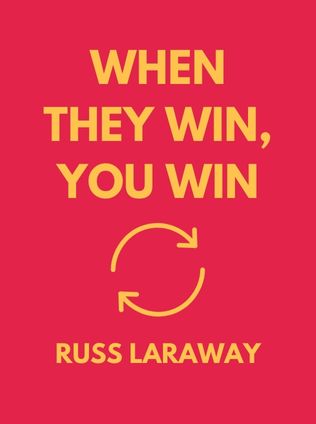
When They Win, You Win
Being a Great Manager Is Simpler Than You Think
By Russ Laraway
Published 06/2022
About the Author
Russ Laraway, the author of "When They Win, You Win," is a seasoned expert in the field of employee experience. His career spans nearly three decades and includes diverse roles, from serving as a company commander in the United States Marine Corps to holding key management positions at renowned companies such as Google and Twitter. Laraway's experience and insights into leadership and management stem from his extensive work in helping organizations improve employee engagement and productivity. His methods have been tested and refined in some of the most challenging and dynamic business environments, making him a credible voice in the discussion of effective management practices.
Main Idea
The central premise of "When They Win, You Win" is that employee disengagement is a widespread problem, but it is not the employees who are to blame—it is their managers. Laraway argues that ineffective, poorly trained managers are the root cause of disengagement, which leads to a loss of productivity and profitability in organizations. He proposes that by developing specific leadership skills, managers can significantly enhance their team's morale and performance. The book provides actionable strategies for managers to improve their effectiveness by focusing on clear goals, effective coaching, and career development.
Table of Contents
- Introduction: Bad Management Is a Widespread Problem
- The Root of the Management Problem
- Measuring Employee Engagement
- Factors of Intrinsic Motivation
- Better Management Through Leadership Skills
- Three Key Skills for Effective Management
- Management Focus #1: Goals
- Management Focus #2: Coaching
- Management Focus #3: Career Development
- Conclusion: The Impact of Effective Management
Introduction: Bad Management Is a Widespread Problem
Lack of employee engagement is a pervasive issue across industries, and Laraway starts by identifying the root cause: bad management. According to him, disengagement is not a fault of the employees themselves but rather a symptom of ineffective management. He emphasizes that bad managers are everywhere, and their impact is significant—leading to unhappy, unproductive workers and, consequently, financial losses for companies.
“Bad managers create disengaged, unhappy, and unproductive employees. In short, bad management hurts employees and employers alike.” — Russ Laraway
Laraway's argument is grounded in research, including a Gallup poll that estimates disengaged employees cost U.S. companies between $450 billion to $500 billion annually. This staggering figure underscores the urgency of addressing management practices that contribute to disengagement.
The Root of the Management Problem
Laraway delves deeper into why bad management is so prevalent. One key reason is the common practice of promoting the best employees to management roles without providing them with the necessary training and support. The assumption that a great employee will naturally become a great manager is flawed, as these roles require different skill sets and mindsets. For instance, effective managers need to focus not just on their own performance but on the performance and development of their entire team.
“Great employees won’t necessarily be great managers; the positions require different skill sets and mindsets.” — Russ Laraway
Laraway points out that while promoting talented employees is crucial to retaining them, it is equally important to equip them with the tools they need to succeed as managers. Without proper training, even the best employees can become ineffective leaders, which ultimately harms the organization.
Measuring Employee Engagement
How can managers determine if they are part of the problem? Laraway suggests that the best way to measure a manager's effectiveness is by assessing employee engagement. He breaks down engagement into two key elements: job satisfaction and workplace satisfaction. Job satisfaction relates to how fulfilling an employee finds their work, while workplace satisfaction involves how they feel about the company as a whole.
An engaged employee is one who has high levels of both job and workplace satisfaction. These employees are typically more conscientious, hardworking, and loyal to the company.
Sign up for FREE and get access to 1,400+ books summaries.
You May Also Like
The Subtle Art of Not Giving a F*ck
A Counterintuitive Approach to Living a Good Life
By Mark MansonRich Dad Poor Dad
What the Rich Teach Their Kids About Money - That the Poor and Middle Class Do Not!
By Robert T. KiyosakiHow To Win Friends and Influence People
The All-Time Classic Manual Of People Skills
By Dale CarnegieQuiet: The Power of Introverts
The Power of Introverts in a World That Can't Stop Talking
By Susan Cain



















